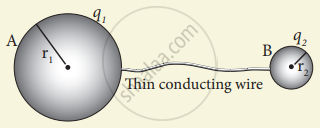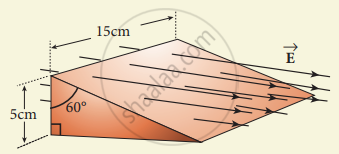Advertisements
Advertisements
प्रश्न
Explain in detail how charges are distributed in a conductor, and the principle behind the lightning conductor.
उत्तर
Distribution of charges in a conductor: Consider two conducting spheres A and B of radii r1 and r2 respectively connected to each other by a thin conducting wire as shown in the figure. The distance between the spheres is much greater than the radii of either spheres.

Two conductors are connected through conducting wire
If a charge Q is introduced into any one of the spheres, this charge Q is redistributed into both the spheres such that the electrostatic potential is the same in both the spheres. They are now uniformly charged and attain electrostatic equilibrium. Let q1 be the charge residing on the surface of sphere A and q2 is the charge residing on the surface of sphere B such that Q = q1 + q2 The charges are distributed only on the surface and there is no net charge inside the conductor. The electrostatic potential at the surface of sphere A is given by
VA = `1/(4 pi eε_0) "q"_2/"r"_2` .....(1)
The electrostatic potential at the surface of the sphere B is given by
VB = `1/(4 pi ε_0) "q"_2/"r"_2` .....(2)
The surface of the conductor is equipotential. Since the spheres are connected by the conducting wire, the surfaces of both the spheres together form an equipotential surface. This implies that
VA = VB or `"q"_1/"r"_1 = "q"_2/"r"_2` ....(3)
Let us take the charge density on the surface of sphere A is σ1 and charge density on the surface of sphere B is σ1. This implies that q1 = `4pi"r"_1^2 sigma_1 and "q"_1 = 4 pi "r"_1^2 sigma_2`. Substituting these values into equation (3), we get
σ1 r1 = σ2r2 ….. (4)
from which we conclude that
σr = constant …. (5)
Thus the surface charge density o is inversely proportional to the radius of the sphere. For a smaller radius, the charge density will be larger and vice versa.
Lightning arrester or lightning conductor:
This is a device used to protect tall buildings from lightning strikes. It works on the principle of action at points or corona discharge. The device consists of a long thick copper rod passing from top of the building to the ground. The upper end of the rod has a sharp spike or a sharp needle.
The lower end of the rod is connected to the copper plate which is buried deep into the ground. When a negatively charged cloud is passing above the building, it induces a positive charge on the spike. Since the induced charge density on thin sharp spke is large, it results in a corona discharge.
This positive charge ionizes the surrounding air which in turn neutralizes the negative charge in the cloud. The negative charge pushed to the spikes passes through the copper rod and is safely diverted to the Earth. The lightning arrester does not stop the •lightning; rather it divers the lightning to the ground safety.
APPEARS IN
संबंधित प्रश्न
What is corona discharge?
Explain in detail the construction and working of a Van de Graaff generator.
A closed triangular box is kept in an electric field of magnitude E = 2 × 103 N C-1 as shown in the figure.

Calculate the electric flux through the
- vertical rectangular surface
- slanted surface and
- entire surface.
